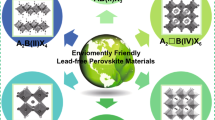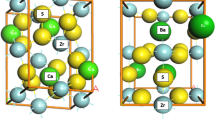Abstract
Perovskite oxides have provided magical structural models for superconducting and colossal magnetoresistance, and the search for nano-scale and/or atomic-scale devices with particular property by specific preparations in the same systems has been extensively conducted. We present here the three oxidation states of manganese (Mn3+, Mn4+, Mn5+) in the perovskite oxide, La0.66Ca0.29K0.05MnO3, which most interestingly shows the rectifying effect as atomic-scale p–n junctions (namely FY-Junctions) of single crystals and films. The family of cubic perovskite oxides were synthesised by the so-called hydrothermal disproportionation reaction of MnO2 under the condition of strong alkali media. The new concept of the atomic-scale p–n junctions, based on the ideal rectification characteristic of the p–n junctions in the single crystal, basically originates from the structural linkages of [Mn3+–O–Mn4+–O–Mn5+], where Mn3+ \( {\left( {{\text{t}}^{{\text{3}}}_{{{\text{2g}}}} {\text{e}}^{1}_{{\text{g}}} } \right)} \) and Mn5+ \( {\left( {{\text{t}}^{{\text{2}}}_{{{\text{2g}}}} {\text{e}}^{{\text{0}}}_{{\text{g}}} } \right)} \) in octahedral symmetry serve as a donor and an acceptor, respectively, corresponding to the localized Mn4+ \( {\left( {{\text{t}}^{{\text{3}}}_{{{\text{2g}}}} {\text{e}}^{{\text{0}}}_{{\text{g}}} } \right)} \).












Similar content being viewed by others
References
Bednorz JG, Mueller KA (1986) Z Phys B-Condensed Matter 64:189
von Helmolt R, Wecker J, Holzapfel B, Schultz L, Samwer K (1993) Phys Rev Lett 71:2331
Tokura Y (2000) In: Sarma DD, Kotliar G, Tokura Y (eds) Advances in condensed matter science. vol. 2. Gordon and Breach Science Publishers, The Netherlands, pp 1–353
Renner Ch, Aeppli G, Kim B-G, Soh Y-Ah, Cheong S-W (2002) Nature 416:518
Millis AJ (1998) Nature 392:147
Rao CNR, Cheetham AK, Mahesh R (1996) Chem Mater 8:2421
Zener C (1951) Phys Rev 82:403
Schaak RE, Mallouk TE (2002) Chem Mater 14:1455
Woodward PM, Cox DE, Moshopoulou E, Sleight AW, Morimoto S (2000) Phys Rev B 62:844
Banach G, Temmerman WM (2004) J Phys: Condens Matter 16:S5633
Alonso JA, Martinez-Lope MJ, Casais MT, Garcia-Munoz JL, Fernandez-Diaz MT (2000) Phys Rev B 61:1756
Feng S, Xu R (2001) Acc Chem Res 34:239
Morale J, Sanchez L, Bach S, Pereira-Ramos JP (2002) Mater Lett 56:653
Feng S (1996) in Proceedings of the 2nd International Conference on Solvo-thermal Reactions, Takamatsu, (Org. Comm. Solvothermal Tech. Res. Ed. Japan, 1996) p. 118
Formula La0.66Ca0.29K0.05MnO3, space group Pm−3m, a = 3.8864(4) Å, V = 58.701(10) Å3, Z = 1, D c = 5.890 g/cm3, μ = 17.731 mm−1, F(000) = 93, crystal size = 0.03 × 0.03 × 0.02 mm3. Intensity data were collected on a Rigaku RAXIS-RAPID diffractometer (Mo-Kα, graphite-monochromator) at a temperature of 293 ± 2 K. The data processing was accomplished with the PROCESS-AUTO processing program. A total of 931 reflections (5.25 < θ < 27.22°) were collected, of which 26 unique reflections (R int = 0.0750) were used. The structure was solved using the program SHELXS-97 and refined (5 parameters) using the program SHELXS-97 to R 1 (I ≥ 2σ (I)) = 0.0381 and wR 2 = 0.1052. The La, Ca and K atoms occupied the same A-site. EXYZ and EADP were used to constrain the La/Ca/K ratio to 0.66/0.29/0.05 as measured by the ICP analysis. Further details of the crystal structure investigation may be obtained from the Fachinformationszentrum Karlsruhe, D-76344 Eggenstein-Leopoldshafen (Germany), on quoting the deposition number CSD 391346. The La, Ca and K atoms occupied the same A site.
Noginov MA, Loutts GB, Noginova N, Hurling S, Kück S (2000) Phys Rev B 61:1884
Bridges F, Booth CH, Anderson M, Kwei GH, Neumeier JJ, Snyder J, Mitchell J, Gardner JS, Brosha E (2001) Phys Rev B 63:214405
Reiche I, Vignaud C, Champagnon B, Panczer G, Brouder C, Morin G, Sole VA, Charlet L, Menu M (2001) Am Mineralogist 86:1519
Graft M, Reisfeld R, Panczer G (2005) Modern luminescence spectroscopy of minerals and materials. Springer-Berlin Heidelberg, New York, p 191
Shaker AM (2001) Int J Chem Kinetics 33:605
Jáky M, Simándi LI (1972) J Chem Soc Perkin II:1481
Deghoul F, Chermette H, Rogemond F, Moncorgé R, Stückl C, Daul C (1999) Phy Rev B 60:2404
Quarez E, Roussel P, Pérez O, Leligny H, Bendraoua A, Mentré O (2004) Solid State Sci 6:931
Otsuka Y, Naitoh Y, Matsumoto T, Kawai T (2003) Appl Phy Lett 82:1944
Wu Ch-G, Chang S-S (2005) J Phys Chem B 109:825
Ng M-K, Lee D-Ch, Yu L (2002) J Am Chem Soc 124:11862
Xu D, Watt GD, Harb JN, Davis RC (2005) Nanoletters 5:571
Aviram A, Ratner MA (1974) Chem Phys Lett 29:277
Kronik L, Shapira Y (1999) Surf Sci Rep 37:1
Kane BE (1998) Nature 393:133
Acknowledgements
We thank Professors Martha Greenblatt, Kenneth Poeppelmeier, and Mark Ratner for helpful discussion. This work was supported by the National Nature Science Foundation of China (20631010 and 20121103) and the National High Technology Research and Development Program of China (863 Program) (No. 2006AA03Z410).
Author information
Authors and Affiliations
Corresponding author
Rights and permissions
About this article
Cite this article
Feng, S., Yuan, H., Shi, Z. et al. Three oxidation states and atomic-scale p–n junctions in manganese perovskite oxide from hydrothermal systems. J Mater Sci 43, 2131–2137 (2008). https://doi.org/10.1007/s10853-007-1988-9
Received:
Accepted:
Published:
Issue Date:
DOI: https://doi.org/10.1007/s10853-007-1988-9




